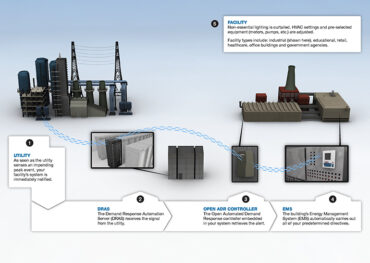Demand Response / Frequency Regulation

Add Additional Revenue Streams to your Operation by Participating in Demand Response
Demand response (DR) is the temporary reduction of electrical usage by a customer for an economic or emergency response. DR Programs are designed to contribute to energy load reduction during times of high prices, critical peak demand, or supply shortfalls on the electric grid. Participants earn recurring revenues for their availability to reduce their demand, by effectively committing their unused capacity as a new and reliable resource to the grid.
Why Demand Response is Important & How DR Works
The U.S. Department of Energy (DOE) estimates that the demand for electricity will continue to grow at record levels through the year 2025. Unfortunately, as demand for energy increases, generating capacity and power plants are reaching maturity and being retired. Because constructing new power plants is difficult and costly, generation cannot keep pace with demand. Inadequate transmission capacity (the ability to get the power to where it is needed when it is needed) is another issue facing policy makers and energy markets.
To combat generation and transmission limitations, Demand Response (DR) and “Smart Grid” technologies are providing opportunities to reduce strain on our electric grid, while providing savings and revenue generating opportunities for customers.
DR programs are administered and paid out by the local grid operator, known as the Independent System Operator (ISO) or Regional Transmission Organization (RTO). PJM Interconnection is the RTO serving New Jersey and Pennsylvania, while New York ISO handles the State of New York. To participate in DR programs customers must work with designated entities known as Curtailment Service Providers (CSP).
There are currently three primary demand response programs available to customers in PJM territory; and each involves different load shedding response times, durations, and pay outs:
- Capacity
- Synchronous Reserves
- Real-Time Economic or Real-Time Energy
Grid operators also have a program known as Frequency Regulation, which pays customers significant financial incentives to modulate power frequency in an effort to help the power grid maintain a stable frequency of 60 Hz (as required by FERC).
3 Year Customer Revenue Example – 1,000 kW in PJM Eastern Mid-Atlantic Region
| 2016 Capacity | 2017 Capacity | 2018 Capacity | Event Energy | Real Time Energy | Sync. Reserves | 3 Year Total |
|---|---|---|---|---|---|---|
| $43,460 | $38,700 | $78,880 | $5,550 | $28,800 | $54,380 | $249,770 |
Assumptions: 1000 kW (1 MW) of DR Event Energy for one (1) 2 hr event/year. Real Time Energy standing bid at $500 for ≈20 hours of annual participation. Reserves availability 8 am – 5 pm, 365 days/year. Back Up Generators may be eligible pending air permit review. PJM Shut Down Costs Reimbursement not included.
Automated Demand Response – AutoDR
Sander Mechanical not only assists customers with navigating through the complex landscape of Demand Response, but helps them leverage the power of their Building Automation System to participate in DR (and regulate frequency) in a fully-automated fashion.
Since manual demand response is labor intensive (e.g. facilities personnel get a phone call and manually shut off lights and equipment), it often takes too long to enable participation in the Reserves and Economic DR programs, which require that facilities shed load within a very short window from the time a DR event occurs. Fully automated DR, however, does not involve human intervention, and is automatically initiated at a facility through an external communications signal. Automated DR is the most efficient method for reliable load reductions and maximum revenues.
Sander helps clients understand where curtailment will have the least intrusive impact to their operation and where the best return will be realized. We work with facility managers and CSPs to determine what demand can be reduced and “how” to get it done. We utilize the building management system to program how the lights, temperature, microturbines, chillers, compressors, and other electrical and mechanical equipment will be sequenced and manipulated to reduce consumption and drop load. We use revenue-grade, ANSI calibrated energy metering devices to ensure that proper Measurement and Verification (M&V) is in place. These tools are integrated with the BMS to quantify loads shed and demonstrate that curtailment obligations have been met.
By linking pricing signals and curtailment requests from the grid operator to field devices with rule-based logic, an automated-DR sequence can be initiated, ensuring that opportunities are not missed when event notification fails to reach an individual who can respond.
Although automation is essential for a reliable program, the ability to exercise manual intervention is still needed to make overrides, alter programmed curtailment levels, monitor status, and adjust logic parameters. Sander makes this possible through creation of an internet-based user interface and custom DR dashboard so that decision makers can access their systems from any web browser and remain in control from anywhere, at any time.

Control Your Energy Future
Utilizing OpenADR and the Tridium-Niagara Framework, Sander delivers a reliable platform for auto-DR that connects utilities and grid operators with the energy consuming equipment in facilities, to seamlessly create additional revenue streams. Contact us today to determine if your facility is a good candidate to take advantage of these programs.

